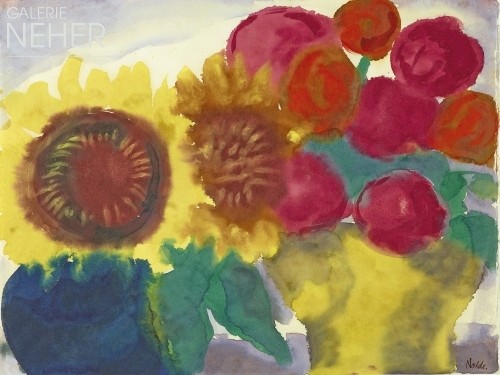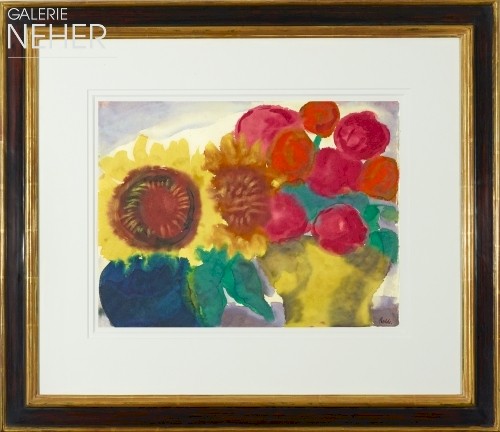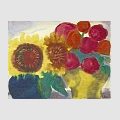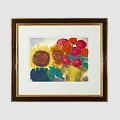Emil Nolde - Sonnenblumen mit Pfingstrosen (Sunflowers with Peonies), ca. 1930
Watercolour on Japan paper
36 x 48 cm / framed 70 x 80 cm
14 x 18 inch / framed 27 x 31 inch
Signed bottom right "Nolde"
Photographic expertise Prof. Dr. Manfred Reuther, previous director of the Nolde Stiftung Seebüll, from 03.11.2014
- with craftsman's frame an UV light consuming pane -
N 9139
Expertise:
Fotoexpertise Prof. Dr. Manfred Reuther, ehemaliger Direktor der Nolde Stiftung Seebüll vom 3.11.2014
Provenance:
Sammlung Ernst Henke, Essen
(vermutlich direkt bei Emil Nolde gekauft) (mündliche Auskunft Prof. Dr. Manfred Reuther vom 29.5.2018)
Exhibitions:
Essen, Galerie Neher, Frühjahr 2020. Kunst aus dem 20. Jahrhundert, Katalog mit farbiger Abbildung Seite 27
Emil Nolde - Sonnenblumen mit Pfingstrosen (Sunflowers with Peonies), ca. 1930
Watercolour on Japan paper
36 x 48 cm / framed 70 x 80 cm
14 x 18 inch / framed 27 x 31 inch
Signed bottom right "Nolde"
Photographic expertise Prof. Dr. Manfred Reuther, previous director of the Nolde Stiftung Seebüll, from 03.11.2014
- with craftsman's frame an UV light consuming pane -
N 9139
Expertise:
Fotoexpertise Prof. Dr. Manfred Reuther, ehemaliger Direktor der Nolde Stiftung Seebüll vom 3.11.2014
Provenance:
Sammlung Ernst Henke, Essen
(vermutlich direkt bei Emil Nolde gekauft) (mündliche Auskunft Prof. Dr. Manfred Reuther vom 29.5.2018)
Exhibitions:
Essen, Galerie Neher, Frühjahr 2020. Kunst aus dem 20. Jahrhundert, Katalog mit farbiger Abbildung Seite 27
About the work
Floral and garden paintings constitute an integral element of Emil Nolde's output. Having informed his work throughout his life, this motif held a special fascination for him, which was described by the artist himself as follows: "The colours of the flowers exerted an irresistible appeal on me, and almost immediately I found myself painting. (…) The blossoming colours of the flowers and the purity of these colours – I simply loved them. And I loved what fate held in store for the flowers: springing up, blooming, radiating, glowing, delighting, wilting and then finally withering." Inspired by his immediate and empathetic experience of unspoiled nature and by the lush and exuberant growth of the flower garden, which from around 1905 characterised the environs of his house on the Baltic island of Alsen and subsequently in Seebüll, Nolde began to intensively explore the colourfulness, the physical presence, the expressivity and emotional radiance of this subject in his numerous paintings and watercolours. Yet his interest was aroused less by neatly–arranged flowers in vases and more by the untrammelled fecundity of vegetation in its natural surroundings – as part of primordial nature. For Emil Nolde the watercolour provided the ideal medium with which to give expression to his artistic intentions. In the uninhibited flow of the paint on the highly absorbent Japan paper, he explored the possibilities of executing an unconventional pictorial composition. Raised to their maximum luminosity, the colours are imbued with heightened expressivity, and the absence of meticulously rendered forms or details only enhances the impact of the pure colours through the virtuosic deployment of the wet–in–wet technique, in which the paint is applied to premoistened paper: blurred contours, diffuse overlayering, transparent bands of colour, streaks and watermarks as well as a subtle interpenetration of colour and surface, the pictorial subject and the surrounding space determine the statement and impact of this floral watercolour. Captured from a close–up perspective, this highly embellished, format–filling motif assumes a grandeur and monumentality. Frequently the underlying paper white bleeds through to the surface and intensifies the enormous radiance of the colours. In a manner characteristic for his richly coloured and light–drenched paintings, Nolde avails himself of the distinctive characteristics of the watercolour: with rapidly applied, instinctive brushstrokes, inspired by his immediate observations, he amplifies the inherent qualities of the colours; and through his concentration and resolution of form and surface, he lends the representation an authentic freshness and buoyant lightness. With this present floral work, as expressive as it is delicate, Nolde proves himself once again to be a twentieth–century master of watercolour.
(Andreas Gabelmann)
Text authored and provided by Dr. Andreas Gabelmann, Art Historian
Dr. Andreas Gabelmann, art historian, born 1967 in Landau. Programmes of study in art history, architectural history and literature in Karlsruhe and Bamberg. 1999 Doctoral thesis on the Badenese Expressionist August Babberger (1885-1936). 2000 to 2002 Practical training at the Brücke-Museum Berlin. 2003 to 2004 Scientific staff member of the Städtisches Kunstmuseum Singen. Since 2005, active as a freelance art historian, author and curator for museums, art associations, galleries, foundations, artist estates, the press and publishing houses in Germany and Switzerland. Numerous publications on modern art with a focus on Expressionism and extending to contemporary art. Publication of the new catalogue raisonné of the printed graphic works of Erich Heckel (will appear in autumn of 2021). Lives and works in Radolfzell on Lake Constance.






